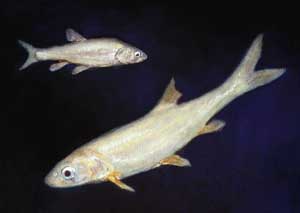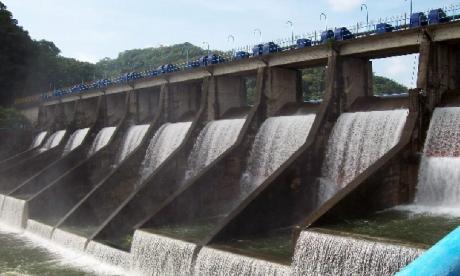
by Deep Green Resistance News Service | Aug 20, 2012 | Biodiversity & Habitat Destruction
By Lawrence Del Gigante / Inter-Press Service
“While each project proposed in Cambodia comes with a different set of impacts, large dams are likely to widen the gap between the rich and the poor, increase malnourishment levels and lead to an environmentally unsustainable future,” Ame Trandem, South East Asia programme director for International Rivers, told IPS.
Four dam projects have been approved so far in Cambodia, with one already operational. All are being developed by Chinese companies on build-operate-transfer agreements, according to Trandem.
The Mekong River runs through six countries, including China and Vietnam, most of which are planning the construction of hydroelectric dams.
“The plans to build a cascade of 11 Mekong mainstream dams is one of the greatest threats currently facing Cambodia,” said Trandem.
The mandate on planning and development of hydropower in Cambodia lies within the ministry of industry, mines and energy, which did not respond to requests for comment.
Another danger of damming the Mekong is the threat to the Mekong delta, an extremely fertile area of land which is responsible for much of the region’s rice supply.
“As the Mekong River feeds and employs millions of people in the region for free, it would be irresponsible to proceed with the Xayaburi and other mainstream dams,” said Trandem.
The Mekong is one of the only rivers in the world to reverse its flow in the dry season. This natural mechanism buffers the intrusion of salt water from the South China Sea into the delta, and could be upset by upstream development.
Dams also block fish migration routes, alter flows, and change aquatic habitats, so these projects are also likely to have an adverse effect on Cambodia’s fisheries.
“The Mekong River Commission’s Strategic Environmental Assessment warned that more than one million fisheries-dependent people in Cambodia would lose their livelihoods and even more would suffer from food insecurity,” said Trandem.
“The loss of even a small percentage of the Mekong’s fisheries can represent in a loss of tens of millions of dollars.”
Partnerships have been established between the countries through which the Mekong runs in order to prevent overharvesting of the river’s resources. However, China is not a signatory to the 1995 Mekong Agreement, and can effectively build these projects independently from downstream countries. The dams in Cambodia are being financed by Chinese investors.
“The impacts of these projects are already being felt downstream,” said Trandem.
Hydroelectricity, even if a successful venture, will not solve the country’s electrification problems, other analysts say.
“Right now it is relatively catastrophic, the power situation in the country,” Alexander Ochs, the director of climate and energy at the Washington-based Worldwatch Institute, told IPS.
Cambodia has one of the lowest electrification rates in Southeast Asia, estimated at only 24 percent, according to the Asian Development Bank (ADB).
The government aims to raise the national electrification rate to 70 percent by 2020, according to the ADB, by expanding the grid and sourcing more than half of the needed electricity from the Mekong River.
A large complication is transmitting the electricity, with only the major cities and surrounding areas having access to power lines, meaning people in rural areas will not benefit from the hydro.
“The number of people that are really connected to a grid as we know it, a modern power service or energy line, in rural areas is as little as seven percent of the population. Overall, nationwide, it’s about 15 percent,” said Ochs.
Read more from Inter-Press Service: http://www.ipsnews.net/2012/08/cambodias-hydro-plans-carry-steep-costs/

by Deep Green Resistance News Service | Aug 11, 2012 | Biodiversity & Habitat Destruction, NEWS
By US Geological Survey
From 1900-2010, freshwater fish species in North America went extinct at a rate 877 times faster than the rate found in the fossil record, while estimates indicate the rate may double between now and 2050. This new information comes from a U.S. Geological Survey study to be published in the September issue of the journal BioScience.
In the fossil record, one freshwater fish species goes extinct every 3 million years, but North America lost 39 species and 18 subspecies between 1898 and 2006. Based on current trends in threatened and endangered fish species, researchers estimate that an additional 53-86 species of freshwater fish may be extinct by the year 2050. Since the first assessment of extinct North American freshwater fishes in 1989, the number of extinct fishes increased by 25 percent.
“This study illustrates the value of placing current events into the context of deep geologic time, as rocks preserve an unbiased record of natural rates of processes before human activities began to alter the landscape, the atmosphere, the rivers, and oceans,” said USGS Director Marcia McNutt. “Freshwater fish are a good choice for analysis as their bones make clear fossil impressions, and their lake and river environments produce excellent stratigraphic sequences.”
The study’s author, Noel Burkhead, used an established method to compare the rate of extinction found in the fossil record with modern rates.
“Estimates of freshwater fish extinctions during the twentieth century are conservative, because it can take 20-50 years to confirm extinction,” said Burkhead, a research fish biologist for the USGS.
Extinction is a natural process, Burkhead explained, so examining its rate over a long geological timescale provides biologists with a benchmark for comparing current extinctions to background rate. The accelerated pace of extinction observed since the beginning of the twentieth century suggests human causes.
In North America, assessments of extinctions are conducted by the American Fisheries Society’s Endangered Species Committee, using categories to factor in a lag time since the last observation of the species. The study used the categories “extinct” (species not seen for 50 years or more), “possibly extinct” (not been seen for 20 years or more), and “extinct in nature.” All these categories require that searches for the missing fishes must have been made by knowledgeable biologists.
“It is extremely rare that the death of the last individual is documented by biologists,” said Burkhead, “although it can happen when a fish only is found in a specific spring or caldera, and it dries up. That’s what happened with five species of desert pupfishes and the Alberca silverside—the last known fish to go extinct in North America.”
The Alberca silverside was found only in the Alberca Caldera, Guanajuato, Mexico; it went extinct when the caldera temporarily dried up in August 2006.
Surprisingly, Burkhead reported that 90-96 percent of fish extinctions in the fossil record were not linked to the five well-known mass extinctions. Natural causes of fish extinction are linked to transitions in landforms and continental watercourses over time, but many twentieth century extinctions were caused by dams, channelization of rivers, water pollution, and other human-induced factors.
The background rate of extinction is based on the fossil record, which includes information on when ancient fishes lived and how long species survived in the geological past. Burkhead used data on fish extinctions from well-known paleontologist Steven M. Stanley at the University of Hawaii.
“Another cause of extinction can be a change in a fish’s food chain, which is what may have happened to the harelip sucker, a really cool fish that used to live in seven states throughout the Ohio River basin,” said Burkhead. “It was a snail-eating specialist with cleft lips that used to pluck snails off river bottoms and manipulate the snail in its mouth in order to suck out the snail’s soft parts, perhaps making little popping sounds. Sadly, snails are highly sensitive to excessive sedimentation and in the late nineteenth century, large amounts of topsoil were washing into rivers along with sewage and industrial effluents from cities. This likely caused snails to decline, which may have been what drove the fish to extinction.”
Declines in freshwater fishes are only the “tip of the iceberg” for freshwater ecosystems, with mussels and snails experiencing declines greater than that of freshwater fishes.
From US Geological Survey

by Deep Green Resistance News Service | Aug 10, 2012 | Biodiversity & Habitat Destruction
By Russ McSpadden / Earth First! Journal
The U.S. Fish and Wildlife service has ordered the killing of an alpha female Mexican gray wolf for crimes against the cattle industry. She is accused of being the ringleader of a six member pack that has killed four cows in southwestern New Mexico over the last several months.
Extirpated from the wild by the 1950s, reintroduced through captive breeding programs in 1998, Mexican gray wolves are far from recovered. The outlaw matriarch of the Fox Mountain Pack—last seen roaming the mountainous woodlands of the northwest portion of the Gila National Forest—is one of only 58 of her kind left in the U.S. Southwest. And though Mexican gray wolves are endangered and federally protected she is now on the federal government’s hit list. There’s no telling how long she and her pups can hold out under the cover of pinion and ponderosa pine or the conifers of the colder peaks of the range with a warrant out for her life.
The ranchers who suffered the loss of cattle have already been reimbursed.
In 2007, the Fish and Wildlife service ordered the shooting of an alpha female of the Durango Pack in the Gila, also for cattle depredation. In a tragic twist of timing, then-governor of New Mexico, Bill Richardson recalled the state’s order but his message arrived too late. She was killed in June of that year. Her lover and their pups disappeared and have not been spotted since. They are presumed dead.
Will the Fox Mountain Matriarch outwit the cattle lobbyists and government assassins long enough for an injunction?
From Earth First! Newswire: http://earthfirstnews.wordpress.com/2012/08/09/outlaw-matriarch-of-the-fox-mountain-pack-ordered-dead-by-feds/
by Deep Green Resistance News Service | Aug 10, 2012 | Biodiversity & Habitat Destruction, Mining & Drilling
By Uranium Network
A foreign uranium mining conglomerate will be allowed to exploit the precious Selous Game Reserve in Tanzania after the World Heritage Committee (WHC) decided, at its July 2012 session in Russia, to accept what was described as a “minor boundary change” of the site. The change had been requested by the Government of Tanzania, in order to make way for the development of a major uranium mine, Mkuju River Uranium Project, owned by Russian ARMZ and Canadian Uranium One.
The decision to allow the boundary change would allow the Mkuju River uranium project, situated in the South of the Selous Game Reserve at its transition to the Selous Niassa Wildlife Corridor, to go forward.
The Tanzanian Government lobbied heavily for the boundary change, after declaring its intent to ” win the battle” against the UNESCO WHC.
Dozens of environmental groups around the world, many of them members of the German-based Uranium Network, decried the WHC decision which could lead to the creation of 60 million tons of radioactive and poisonous waste by the mine during its 10-year lifespan (139 million tons if a projected extension of the mine should be implemented). The radioactive wastes pose a serious threat to Selous Game Reserve which is home to the world’s largest elephant population and other wildlife. No proven methods exist to keep the radioactive and toxic slush and liquids from seeping into surface waters, aquifers or spreading with the dry season wind into the Reserve.
It remains completely unclear how the company or the Government of Tanzania will guarantee that the impact of millions of tons of radioactive and toxic waste will be “limited”. The WHC decision appears to be influenced by heavy corporate and government lobbying and not by sound science. It sets a horrible precedent that could threaten other World Heritage Sites with similar dangerous and damaging exploitation.
The decision is in stark contrast to previous decisions of the WHC of 2011 stating that mining activities would be incompatible with the status of Selous Game Reserve, a World Heritage site.
The environmental groups question whether WHC members have fully understood and given adequate attention to the implications of a uranium mine – including diesel generators, uranium mill, housing, heavy truck roads, as well as the creation of millions of tons of radioactive and toxic waste which should be contained safely and separate from the environment for thousands of years.
Uranium mining creates radioactive dust, contaminates waterways and groundwater aquifers and depletes often precious water supplies. Once abandoned, the radioactive contamination from the mines can persist for decades or even hundreds of years.
The WHC’s decision was made at a time when Russia was chairing the WHC session in St. Petersburg, Russia; Mkuju River uranium project – which basically lives or dies with the decision on the boundary change – is majority owned by Russian ARMZ, a subsidiary of ROSATOM – who bought it from Australian Mantra Resources earlier in 2012.
The environmental groups urge the World Heritage Committee to reconsider its decision on the Selous Game Reserve Boundary Change and call upon the Government of Tanzania to refrain from licensing a uranium mine in Selous Game Reserve or on lands cut out from it.
From Hamsayeh.net:

by Deep Green Resistance News Service | Aug 3, 2012 | Biodiversity & Habitat Destruction, The Solution: Resistance
By Emilio Godoy / Inter-Press Service
Small-scale hydroelectric dams with a capacity of under 30 MW are seen by the authorities in Mexico as an important alternative for generating energy. But local communities reject them on the argument that they would cause social, economic and environmental damages.
On the front line of the struggle are communities in the southern states of Puebla, Tabasco, Veracruz, Oaxaca and Chiapas, where there is great potential to harness hydro energy with small dams.
“They claim the so-called mini-hydroelectric plants don’t have a negative impact on communities, but people already have the necessary information to know that any kind of dam has an impact,” activist Angélica Castro, coordinator of public advocacy and citizen participation in Services for Alternative Education (EDUCA), told IPS.
EDUCA, a non-governmental organisation in Oaxaca, has been working since 2006 with the people of 39 communities in six municipalities in that state that would be affected by a 510 MW dam that the state Federal Electricity Commission (CFE) plans to build on the Verde River.
The communities, which have joined together in the Council of People United for the Defence of Río Verde (COPUDEVER), are opposed to the construction of the hydroelectric plant, whose environmental and socioeconomic impact studies have not yet been completed.
There are at least 50 public and private small-scale hydropower dams operating in Mexico, most of which are obsolete. Together, they generate around 50 MW of energy.
The National Commission for Energy Savings (CONAE) estimates that the southern states have the potential to produce over 400 MW of energy by mini-dams, at 72 identified locations.
Although Mexico’s southern states are the country’s poorest, they are rich in water, because of the large number of rivers and the high levels of rainfall. The non-governmental Mario Molina Centre reports that in Oaxaca and Chiapas, nearly all of the locally consumed electricity is generated by renewable sources like wind, geothermal and solar power, as well as miniature dams.
Mariana González, a transparency and accountability researcher with the FUNDAR Centre for Analysis and Research, an interdisciplinary organisation that monitors public policies and institutions, told IPS that mini-dams “are profitable in the short-term, but they modify the soil and their surroundings without benefiting local communities.”
Between 2010 and 2012, FUNDAR advised four communities in Oaxaca that would have been affected by the Cerro de Oro small-scale dam, which was to generate 10.8 MW of electricity. The villages managed to block the project.
The companies building the dam had not consulted the local communities before the start of construction, in 2010.
Read more from Inter-Press Service: http://www.ipsnews.net/2012/08/mexican-communities-fight-mini-dams/

by Deep Green Resistance News Service | Aug 2, 2012 | Biodiversity & Habitat Destruction, Mining & Drilling
By Jeremy Hance / Mongabay
Burning coal fuels climate change, causes acid rain, and spreads toxic pollutants into the environment, but now a new Greenpeace report warns that coal may also imperil the world’s biggest feline: the tiger. Home to world’s largest population of tigers—in this case the Bengal subspecies (Panthera tigris tigris)—India is also the world’s third largest coal producer. The country’s rapacious pursuit of coal—it has nearly doubled production since 2007—has pushed the industry into tiger territory, threatening to destroy forests and fragment the tiger’s already threatened population.
“Unfortunately for the tiger, its largest contiguous habitat—Central India—is also where most of India’s coal lies,” Ashish Fernandes, author of the report, told mongabay.com.
India is one of the bright spots in the global effort to save the tiger from extinction. The country now holds around 1,700 tigers, over half of the world’s population of wild tigers. Although India’s tiger population is generally considered to be in decline, there have been some local population increases giving hope that the country can turn around the situation. Yet the tiger still faces poaching and habitat loss, the latter which is likely to be exacerbated by open pit mining for coal.
“Several of India’s largest coalfields (such as Singrauli and Talcher) include forest areas adjoining Tiger Reserves, and where tigers are found. Coal mines are already eating into these areas, and with the ongoing expansion, this will worsen,” Fernandes says.The Bengal tiger, which is considered Endangered by the IUCN Red List, is the undisputed king in these forests, which in some cases also sports populations of leopard (Panthera pardus), Near Threatened; Asian elephant (Elephas maximus), Endangered; sloth bear, (Melursus ursinus), Vulnerable; sambar (Rusa unicolor), Vulnerable; and other non-threatened deer and antelope species.
Analyzes 13 Central Indian coal mines, in various stages of exploitation, the report finds that full open pit mining in these areas would destroy over a million hectares of forest. According to official data, 18 percent of these forests are known to be used by tigers, 27 percent by leopards, and 5.5 percent by elephants. In all, eight of India’s renowned Tiger Reserves will be impacted, potentially harming around 230 tigers or 13 percent of India’s total tiger population.
“India’s Protected Areas/Tiger Reserves are small by global standards, with few larger than 500 square kilometers. As such, if isolated, their tiger populations are not viable in the long term,” Fernandes explains. “Tigers, males in particular, roam large areas in search of mates, and this ensures genetic vibrancy. As young tigers mature, they also need to establish their own territories, or face conflict with dominant males. Corridors help aid this dispersal and ensure a healthy gene flow between different ‘source’ tiger populations.”
India is a signatory of an ambitious conservation plan to double wild tiger populations worldwide by 2022, a plan which was endorsed by all 13 tiger countries in 2010. Worldwide, tigers have been decimated by habitat loss, prey depletion, and hunting, now largely to feed the Chinese medicine trade. The great cats have been left with about 7 percent of their historical range, and already three subspecies have vanished for good.





